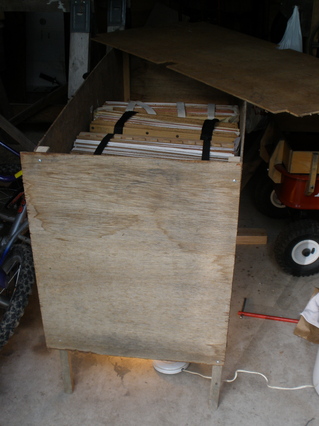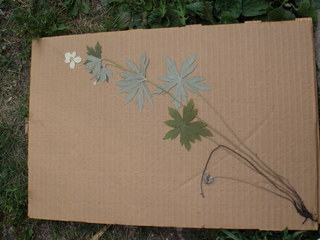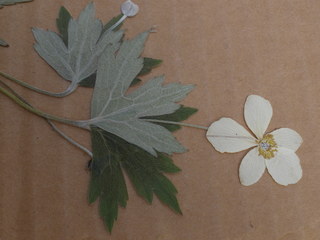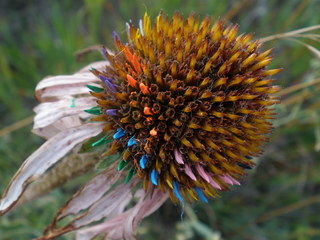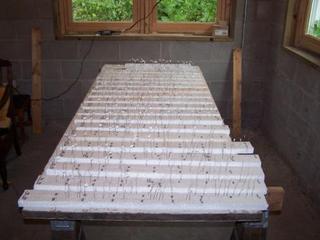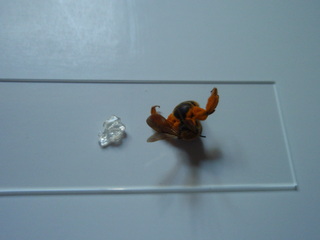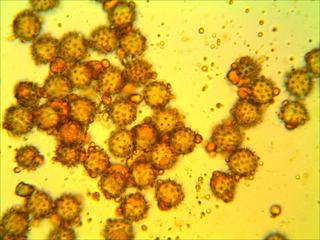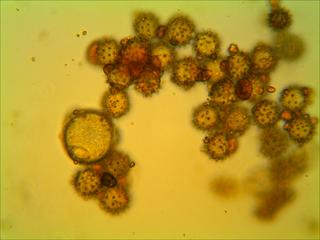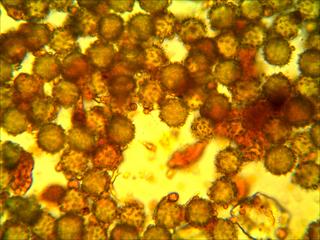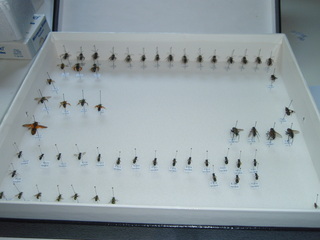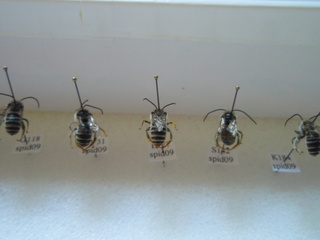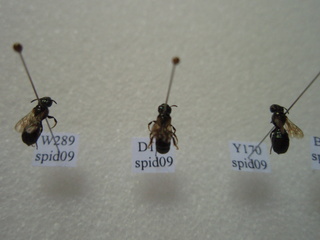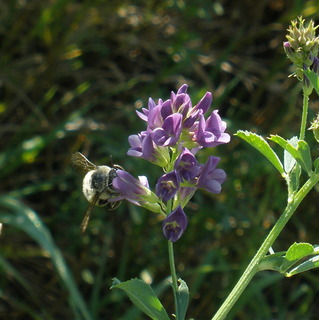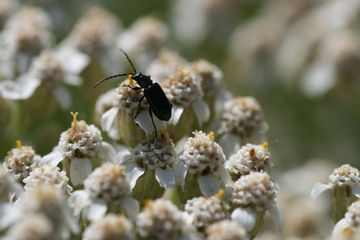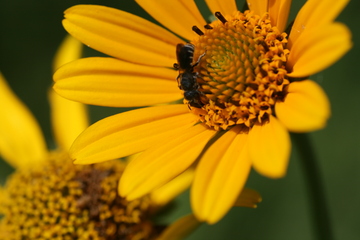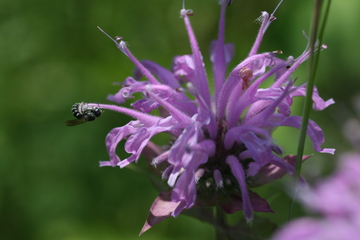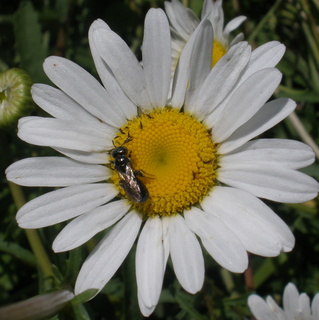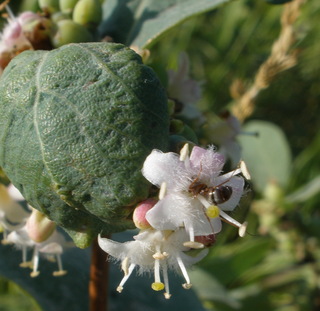|
|
Hello friends,
We just finished a rousing lunchtime discussion on the virtues of archiving, so I thought this might be an appropriate time to post our compiled data set from all four days of pollinator observations and captures.
compiledpollenobs2009.xls
Here are files with presence/absence of species within the 2m floral neighborhoods
fnc10mNeighborhood.csv and within 10m floral neighborhoods fnc2mNeighborhood.csv. The first is just a reorganization of FNC.csv and the second includes info from FNC.csv and from WITHIN10M.csv.
Here’s a photo of the box I built for drying plants with generously donated materials from the Wagenius family.

A pressed specimen of Anemone canadensis collected at Hegg Lake with Greg.


One of my painted heads after being repainted this week. Each paint color identifies a pollen treatment.

Thanks to Mimi for letting me use her camera!
I am slowly moving up from the basement to rejoin the world at ground level. Thanks to Caroline for the labels – three sets of slides of co-flowering plants of E. ang. are complete. The pictures are waiting to appear online. Meanwhile, succession of the Hjelm house basement table (door) occurs. As a flowering plant replaces another on the prairie, Stipa spartea seeds have replaced the slides.
Can you see a difference between the pictures?
Wouldn’t you like to peg some Stipa and populate the board?
I think Someone (codename: drone or riddler) may offer a 6-pack to the person who fills the last seed in each hole of each styrofoam “board”. It would be more fun than chasing a chipmunk out of the Hjelm house.


Here is a list of the plants I used in the common garden for my experiment on pollen interference/competition. I used 20 randomly selected plants in the 96 garden with 12 pollination treatments on each plant. The heads I harvested are also included in this spreadsheet, but here they are again: 39 952 blu and wht heads were harvested on 7/24/09.
Baggins.CG.09.xls
The preliminary results seem to show that the only treatments that consistently did not shrivel were:
silver-the control, no pollinations
white-Carduus acanthoides pollen only (thistle)
pink-Coreopsis palmata pollen only
All of the treatments that received echinacea pollen (either am or pm) showed somewhat consistent shriveling…. will it hold up to the stats…. we will see!
the most interesting treatment is…..
purple-Heliopsis helianthoides pollen only- this one had a mix of results, which may be due to differences in the amount of pollen arriving on the styles or some other factor. but it certainly did not show consistent style persistence. hmmmmm…..
Just as a reminder, style shriveling indicates that compatible Echinacea pollen has arrived on a style, and can be a good predictor of seed set. Style persistence indicates that compatible pollen has not landed on a style. In the case of some of my treatments which had both Echinacea pollen and another type of pollen, shriveling may not indicate seed set. This will be tested by dissecting the heads and weighing the seeds later this year.
More results to come soon…
Listen up, Echinacea fans!
I’ve now finished making slides and taking photos of the first 68 insect visitors–only 107 left to go.
Here are some photos of the process:
1) Here is an insect carrying LOADS of pollen (haha! get it?) which I am about to transfer onto a small agar cube on a microscope slide.

2) I heat the slide, complete with pollen-covered agar cube and cover slip, on a hotplate. Next I throw the completed, labeled slide under the microscope camera and take photos like these : :


3) I’ve pinned each specimen with a unique ID code that corresponds to its vial ID number.


The most common genera near as I can tell from the reference collection are…
Male Melissodes sp.

And Ceratina sp.

Please leave questions or comments and I’ll do my best to respond!
-Amanda
So, I’ve been working hard creating slides from all the styles everyone helped to collect (thanks!), and this is the protocol I’ve been using:
II. SLIDE PROTOCOL:
A. ORGANIZE THE STYLE VIALS BY SITE
B. CREATE SLIDE LABELS
C. RANDOMIZE THE STYLE INFORMATION ON EXCEL
D. CREATE THE SLIDES IN THE RANDOM ORDER GIVEN BY EXCEL
1. Place the blank slide on a clean surface
2. Pull out the correct vial, open carefully (sometimes the styles are on the lid of the vial), use clean tweezers to remove the contents. Place vial contents onto the slide.
3. Remove any anther parts from the slide; organize the stigmas so they are separate/easily differentiated from each other.
4. Place one drop of glycerin on top of the stigmas. If there are any bubbles, try to move them away from the stigmas.
5. Place a cover slip carefully over the glycerin and allow it to settle.
6. Use mounting medium to seal the cover slip to the slide. Allow the slide to dry on a flat surface for 24-48 hours.
E. Put completed slides into slide boxes.
Of the approximately 380 slides I started with, I have 150 left to do, so I’m more than 1/2 way there. Once I’ve created all these slides, I’ll start taking photos and uploading pictures.
Anyway, just felt like it was about time I updated. Gonna go make slides now… ^_^
Here is the data that’s been compiled for FNC, pollinator observations, within 10 m, and the isolation measure of flowering Echinacea focal plants.
Some things I wanted to point out that may or may not make a difference:
>In the FNC data, all quadrants with none present have no data for distances, and sometimes there is only one distance if there was only 1 infl of a species within a quadrant…
>I still need to check each tag number that we recorded for FNC and make sure it coincides with the original record of tags we made when we flagged.
>For the isolation measure, I put in 11 for distances >10m. I marked the original distance in the notes in cases where they were >10m but measured out (i.e.SPP)
>For inflorescence counts>100, I put in 1000. In the comparison file below, we changed 1000 to 101 since we had to sum the inflct for each unique ID and so some of the infl ct were showing up as >1000.
ISOLATION.csv
FNC.csv
POLLOBSWITHFLIES.csv
POLLOBSWITHOUTFLIES.csv
WITHIN10M.csv
pollcomparison ecan mesa amca.csv
ech mesa comparison with mean std error.csv
ech amca comparison with mean sterror.csv
As of 8/3:The last 2 files are new. In order to make the graph that appears on my poster, we divided the unique Id’s into 4 groups: 1-alfalfa only in fl.neighborhood 2-ech only 3-both 4-neither. I took the average and standard error from each of those 4 groups to make the 4 bars on the graph. I want to do the same thing for Amorpha. So I attached the file that I’d use to make the same graph but with amorpha. You could use the third to last file which has infl ct for each unique ID for ecan, mesa, and amca to do the analysis but I figured I’d put the others up so you could know how I made the graph…
FYI, after Amanda and I looked at all the vials yesterday, it turns out that over our 4 day stint we had 132 bees, 13 scsf, 33 flies, 4 butterflies, 15 beetles. Good work everyone!
I attached a map of locations in the CG where we will plant Stipa seeds. Black dots are Echinacea locations, red circles are potential Stipa locations, and blue dots are locations we will plant this year. We will plant each Stipa seed relative to an Echinacea location, maybe 10 cm South or 20 cm North. Any thoughts?
mapOfStipaInCG.pdf
|
|

